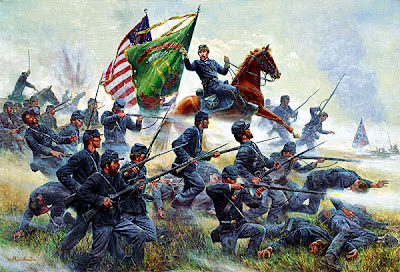The charge of the Irish Brigade
Casualties in "the sunken road"
SHARPSBURG, Md. — A spine of gray limestone runs north and south through the legendary cornfield here, just breaking the surface and leaving a path where no corn can grow.Read the rest here.
For a century and a half, the elements have scoured the dirt, and crops have come and gone. But the stone has remained, scarred and smoothed by the plow and the weather.
On the morning of Sept. 17, 1862, the feet of thousands of desperate soldiers hurried across the ancient rock. Some men fell and bled on it. Bullets and shells flew over it. And somewhere nearby toppled the Lone Star flag of the 1st Texas Infantry Regiment.
In this stony cornfield, the doomed 1st Texas lost, along with its flag, 82 percent of its men. Here, the Civil War’s Battle of Antietam exploded in fury, and here, a crucial, bloody step was taken toward the end of slavery in America.
“Of all the days on all the fields where American soldiers have fought, the most terrible by almost any measure” was here at Antietam, historian Stephen W. Sears wrote in his classic 1983 study of the battle.
In the late summer and fall of 1862, as the Civil War moved through its second year, it had reached frightful new levels of violence, which would grow as the war went on.
But the fight along Antietam Creek, 150 years ago this month, would endure as its bloodiest single-day battle, and its horrors would haunt the soldiers who fought there for years.
For a more detailed discussion of the actual battle see here.










No comments:
Post a Comment